Wrens
 Wrens are small, active birds, basically brown in color, that often
perch with their tails held straight up. They forage on or just above
the ground in thick brush, forest understory or marsh vegetation. Wrens
belong to Family Troglodytidae, with about 70 species in the New World,
most of them in the tropics. Only one species lives in the Old World:
the winter wren, which likely spread from Alaska to Siberia and extended
its range westward until, eons in the past, it reached Britain and
Iceland. Some wrens nest in cavities; others build roofed structures out
of plant matter. The males of several species build "dummy" nests,
preliminary nests placed in tree cavities, woodpecker holes and nest
boxes, and less frequently in odd enclosed spaces such as tin cans,
pockets of clothing hung outdoors, hats, boots, flower pots and
drainpipes. Later, a female will choose one of the male's dummy nests,
finish its construction, and lay eggs in it. Wrens often pester other
birds and evict them from nest cavities, puncturing their eggs or
pecking their young to death. They destroy nests in cavities and in the
open; they also wreck other wrens' nests. Why such belligerence? Does an
abundance of empty nests discourage predators from looking further and
finding an active wren's nest? Or does killing its rivals' offspring
reduce pressures on prey populations, making it easier for a wren to
feed its own young?
Wrens are small, active birds, basically brown in color, that often
perch with their tails held straight up. They forage on or just above
the ground in thick brush, forest understory or marsh vegetation. Wrens
belong to Family Troglodytidae, with about 70 species in the New World,
most of them in the tropics. Only one species lives in the Old World:
the winter wren, which likely spread from Alaska to Siberia and extended
its range westward until, eons in the past, it reached Britain and
Iceland. Some wrens nest in cavities; others build roofed structures out
of plant matter. The males of several species build "dummy" nests,
preliminary nests placed in tree cavities, woodpecker holes and nest
boxes, and less frequently in odd enclosed spaces such as tin cans,
pockets of clothing hung outdoors, hats, boots, flower pots and
drainpipes. Later, a female will choose one of the male's dummy nests,
finish its construction, and lay eggs in it. Wrens often pester other
birds and evict them from nest cavities, puncturing their eggs or
pecking their young to death. They destroy nests in cavities and in the
open; they also wreck other wrens' nests. Why such belligerence? Does an
abundance of empty nests discourage predators from looking further and
finding an active wren's nest? Or does killing its rivals' offspring
reduce pressures on prey populations, making it easier for a wren to
feed its own young?
Wrens eat mainly insects and spiders. A few species will also feed
on berries and seeds. Owls, small hawks and house cats take adult wrens;
raccoons, opossums, minks, weasels, mice, squirrels, woodpeckers and
snakes raid wrens' nests. Some wrens migrate southward in winter, while
other species remain as permanent residents on their breeding range.
Five species are found in Pennsylvania.
» Small buffy songbird.
» Tail often held upward.
» Rusty underparts.
» White eyestripe.
» Loud.
» Size: 12-14 cm (5-6 in)
» Wing span: 29 cm (11 in)
» Weight: 18-22 g (0.64-0.78 ounces)
» Sexes look alike; male slightly larger
Titmices
 Small, active and acrobatic are all apt descriptions of the Tufted
Titmouse. These tiny birds are friendly and fun to watch as they search
for insects under the fallen leaves, along the trunks of trees and well
as in the tree tops. The bird family of Titmice (Paridae) includes 65
species, 12 of which reside in North America. Along with the Tufted
Titmouse, the chickadees, Plain Titmouse, Bridled Titmouse, Oak Titmouse
and the Juniper Titmouse can be found in the U.S. The birds in the
titmouse family are sparrow-sized, with a gray color, lighter
undersides,perky tufted heads and large inquisitive bright dark eyes.
Their beaks are short cone-shaped beak. Male and female titmice look
alike. Tufted Titmice are the normal gray color with their lower parts
light gray and their flanks will be a rusty orange color. They have a
black forehead while the area around the eyes is light gray. And
although the Tufted Titmouse is the largest titmouse, it is only 6.5
inches long, has a wingspan of 10.75 inches and weighs a mere 0.8 ounce!
Small, active and acrobatic are all apt descriptions of the Tufted
Titmouse. These tiny birds are friendly and fun to watch as they search
for insects under the fallen leaves, along the trunks of trees and well
as in the tree tops. The bird family of Titmice (Paridae) includes 65
species, 12 of which reside in North America. Along with the Tufted
Titmouse, the chickadees, Plain Titmouse, Bridled Titmouse, Oak Titmouse
and the Juniper Titmouse can be found in the U.S. The birds in the
titmouse family are sparrow-sized, with a gray color, lighter
undersides,perky tufted heads and large inquisitive bright dark eyes.
Their beaks are short cone-shaped beak. Male and female titmice look
alike. Tufted Titmice are the normal gray color with their lower parts
light gray and their flanks will be a rusty orange color. They have a
black forehead while the area around the eyes is light gray. And
although the Tufted Titmouse is the largest titmouse, it is only 6.5
inches long, has a wingspan of 10.75 inches and weighs a mere 0.8 ounce!
The Tufted Titmouse can be found over nearly the entire eastern half of
the US during both the summer and winter. These non-migratory birds can
be found in deciduous and mixed deciduous-coniferous forests, preferably
near swamps and riversides. The Tufted Titmouse, sometimes called a
Sugar Bird, or Tomtit, is active and agile, hanging upside down from
small branches to feed on insects. They are sociable birds and can be
seen in mixed flocks with chickadees and nuthatches. Not sure if that
quick moving bird high in the branches is a Tufted Titmouse? Listen to
its song. Its song is a loud clear whistle: "Peter, Peter, Peter".
Tufted Titmice are usually eat insects and spiders by clinging to trunks
of trees and branches, but in winter when not many insects are
available, these titmice vary their diet with berries, nuts and seeds.
Fill your hopper feeders with shelled peanuts or black oil sunflower
feed to bring them closer to your windows. Watch them closely and you
might spy them using their beak to pound open the shell while holding
the seed with its feet. You can also try putting out grapes or apple
chunks on a platform feeder. Peanut butter suet is extremely tempting to
them so fill up a suet feeder with it or even smear it on a tree trunk
where they'll discover the treat while climbing all over the trunk. If
you can add a few trees or bushes to your yard, you'll make it more
attractive to these birds. Try planting evergreens, oaks, bayberry,
mulberry, crabapples, blueberries blackberries, grapes, serviceberries
or even lots of sunny sunflowers. These small birds are cavity-dwellers,
nesting in the wild in old woodpecker holes or tree cavities. In your
yard, put up nesting boxes mounted about 5-10 foot off the ground in an
area with trees. Make sure they see your birdhouse by placing some
nesting material stuffed into a suet holder and hang it near the house
from March to July when they are busy breeding.
» Description: The Tufted Titmouse is an active, noisy, and
conspicuously vocal bird whose typical song is a loud whistled peter
peter peter. Both sexes have a distinctive black forehead and gray
crest. The upperparts are gray, with slightly darker gray flight
feathers. The lores are pale buff. The face and underparts are white
with rufous flanks. The dark eye and eye ring are prominent on the white
face.
» The Tufted Titmouse's range throughtout the eastern United States has
grown steadily northward during this century. This expansion may be
linked to the growing number of people feeding birds each year
Sparrows

Golden-crowned Sparrows consume an almost entirely vegetarian diet while
on their wintering range. They eat buds and flowers, to the extent that
they may exact a toll on California gardens. They are especially fond
of sprouted seeds, including those of garden vegetables. Little is known
of their breeding biology, but it is thought that insects make up a
large percentage of their summer diet and that nestlings are fed nearly
100 percent insects.The Golden-crowned Sparrow, like other "crowned"
sparrows—the White-crowned (Z. leucophrys) and the White-throated (Z.
albicollis) sparrow—is a largish, relatively long-tailed sparrow with a
striking head pattern. It is a western species that largely replaces the
White-crowned Sparrow along the Pacific Coast and adjacent mountain
areas. Golden-crowned Sparrows breed in alpine and tundra areas from
Alaska to extreme northwest Washington. They frequent alder and willow
thickets, or dwarf conifers, often above or beyond the tree line as long
as there are sufficient numbers of small bushes and scrub. The song of
three, clear, whistled descending notes, (three blind mice or oh dear
me) is sung by males from exposed perches.
» Length: 5.5 inches
» Conical bill
» Brown crown
» Grayish face and supercilium
» Brown streak extends behind eye
» Thick malar streak
» Brown back with darker streaks
» Brown wings with some rust
» Underparts white with heavy dark streaks and central breast spot
» Long, brown, rounded tail
» Sexes similar
» Juvenile (Summer) similar to adult but buffier
» Considerable variation in plumage across its range from dark to rusty upperparts and in bill size and shape.
Limpkins
 Looking like something between a crane and a rail, this odd wading bird
has no close relatives. It is widespread in the American tropics, but
enters our area only in Florida, where it can satisfy its dietary
requirement for a certain freshwater snail. Mostly solitary, Limpkins
may be overlooked as they stalk about in marshes and swamps, but they
certainly draw attention with their piercing banshee wails, often heard
at dawn or at night. Its cry is a piercing, repeated wail, kree-ow,
kra-ow, etc., etc., especially at night and on cloudy days.
Looking like something between a crane and a rail, this odd wading bird
has no close relatives. It is widespread in the American tropics, but
enters our area only in Florida, where it can satisfy its dietary
requirement for a certain freshwater snail. Mostly solitary, Limpkins
may be overlooked as they stalk about in marshes and swamps, but they
certainly draw attention with their piercing banshee wails, often heard
at dawn or at night. Its cry is a piercing, repeated wail, kree-ow,
kra-ow, etc., etc., especially at night and on cloudy days.
A large spotted swamp wader, it stands about 28 inches tall. The Limpkin
is found in open freshwater marshes, along the shores of ponds and
lakes, and in wooded swamps along rivers and near springs. Limpkin's
favorite food is large apple snails (genus Pomacea). In Florida, it also
eats other kinds of snails and mussels; sometimes insects, crustaceans,
worms, frogs, lizards.
» Length: 22 inches Wingspan: 42 inches
» Large long-necked long-legged wading bird; with neck extended in flight
» Long, slightly decurved bill with yellowish-orange base and dark tip
» Often flicks and cocks short tail while walking a high-stepping gait
» Dark brown plumage
» Head, neck, and underparts streaked extensively with white
» Back and upperwing coverts have bold white spots and streaks
» Immature similar to adult, but paler
» White-streaked underwing coverts visible in flight
» Sexes similar
Kinglets
 Ruby-crowned Kinglets are one of our smallest birds, measuring only 4.25
inches and weighing about one-quarter of an ounce. For their size, they
lay one of the largest clutches of eggs of any North American songbird,
averaging nearly 8 eggs per clutch, with as many as 12 eggs recorded in
a single nest.Ruby-crowned Kinglets typically build their nests close
to the trunk high in a conifer. The nests are suspended from twigs below
a sheltering and concealing horizontal branch. Often deeper than they
are wide, with constricted openings, they conceal the brooding adult so
that only the tip of her tail can be seen.
Ruby-crowned Kinglets are one of our smallest birds, measuring only 4.25
inches and weighing about one-quarter of an ounce. For their size, they
lay one of the largest clutches of eggs of any North American songbird,
averaging nearly 8 eggs per clutch, with as many as 12 eggs recorded in
a single nest.Ruby-crowned Kinglets typically build their nests close
to the trunk high in a conifer. The nests are suspended from twigs below
a sheltering and concealing horizontal branch. Often deeper than they
are wide, with constricted openings, they conceal the brooding adult so
that only the tip of her tail can be seen.
In the eastern part of the range, the highest population densities occur
in the black spruce bogs and muskegs of Canada, whereas in the West,
spruce-fir, lodgepole pine, and Douglas fir forests are used. The
breeding range encompasses most of Canada and Alaska, extending south in
the east to Maine, northern New England, and the Adirondacks; in the
West, the breeding range extends south throughout the Rocky Mountains
and mountain ranges of California.
» Very small, active bird that often flicks its wings
» Thin bill
» Broken eye ring
» Olive upper parts
» Pale olive under parts
» White wing bars
» Male has red patch in center of crown (not always visible)
» Habitat Prefers coniferous forests on breeding grounds. Common in
deciduous woods and thickets during winter months in the south.
Kingfisher
 Kingfishers are chunky birds. They have short necks and large heads, and
many of them sport crests that they can raise. They have long beaks,
short legs and small, weak feet. They're usually brightly coloured.
Kingfishers are mainly solitary birds. Some kingfishers eat fishes,
amphibians, crustaceans and water insects, which they catch by diving
into the water head-first. Most eastern hemisphere kingfishers don't
fish, and the forest or wood kingfishers may live far from water. The
fishing kingfishers dig burrows for nesting in riverbanks or creek
banks. They dig with their beaks and push the dirt out of the burrows
with their feet.
Kingfishers are chunky birds. They have short necks and large heads, and
many of them sport crests that they can raise. They have long beaks,
short legs and small, weak feet. They're usually brightly coloured.
Kingfishers are mainly solitary birds. Some kingfishers eat fishes,
amphibians, crustaceans and water insects, which they catch by diving
into the water head-first. Most eastern hemisphere kingfishers don't
fish, and the forest or wood kingfishers may live far from water. The
fishing kingfishers dig burrows for nesting in riverbanks or creek
banks. They dig with their beaks and push the dirt out of the burrows
with their feet.
Birding Guide Featured Topic
» Description: About 13 inches long, the male is blue gray with a white
collar, a blue gray band across the breast and a white belly. The female
has an additional rust colored band around the belly.
» Habitat: Belted kingfishers are found near salt and fresh water. Their
nest is a chamber at the end of a 3 to 15 foot tunnel often in a river
or coastal bank.
» Foods: Belted kingfishers are loners except during the nesting season.
Then they mate and work together to dig their tunnel and raise their
young before they go their separate ways again.
 Perhaps best-known for its being cursed by sailors as a harbinger of bad
luck, this bird of the world's southern oceans spends long periods at
sea, covering several thousand kilometers on a single foraging trip, and
comes to shore seasonally to nest. It is long-lived, with an estimated
life-span of 30-40 years, and is one of sixteen albatross species
identified as globally threatened in recent years, in large part due to
drowning on fishery longlines Albatrosses range in length from 50 to 125
cm (20 to 50 in). Plumage varies from white through dark gray or
gray-brown, with combinations of all three being common. The large
hooked bill, covered with horny plates, has characteristically prominent
tubular nostrils. The three front toes are webbed, and the rear toe may
be absent or vestigial. Albatrosses live on land only during the
breeding season, usually nesting in colonies on the shores of remote
oceanic islands. Courtship displays are highly elaborate. Incubation of a
single large white egg lasts two to three months.
Perhaps best-known for its being cursed by sailors as a harbinger of bad
luck, this bird of the world's southern oceans spends long periods at
sea, covering several thousand kilometers on a single foraging trip, and
comes to shore seasonally to nest. It is long-lived, with an estimated
life-span of 30-40 years, and is one of sixteen albatross species
identified as globally threatened in recent years, in large part due to
drowning on fishery longlines Albatrosses range in length from 50 to 125
cm (20 to 50 in). Plumage varies from white through dark gray or
gray-brown, with combinations of all three being common. The large
hooked bill, covered with horny plates, has characteristically prominent
tubular nostrils. The three front toes are webbed, and the rear toe may
be absent or vestigial. Albatrosses live on land only during the
breeding season, usually nesting in colonies on the shores of remote
oceanic islands. Courtship displays are highly elaborate. Incubation of a
single large white egg lasts two to three months.









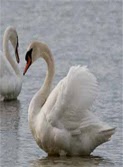






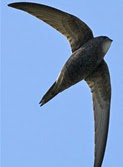



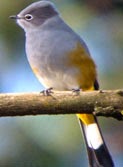

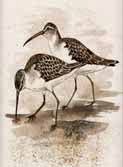



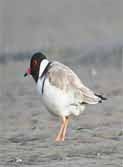
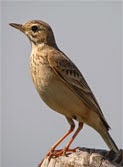





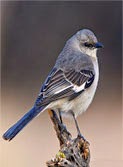

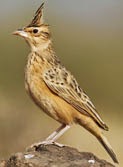



0 comments: